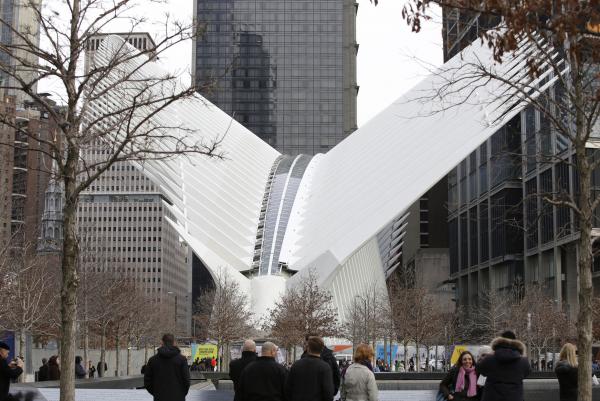The Oculus
| Line 33: | Line 33: | ||
* The Big Basket. | * The Big Basket. | ||
* The Gherkin. | * The Gherkin. | ||
| + | * The Lowline. | ||
* The Mile. | * The Mile. | ||
* Unusual building design of the week. | * Unusual building design of the week. | ||
Revision as of 16:46, 18 July 2016
The World Trade Center Transportation Hub in Lower Manhattan was officially opened to the public on 4 March 2016, replacing the PATH train station that was destroyed in the 9/11 attacks. It provides access to Port Authority Trans-Hudson (PATH) commuter trains to New Jersey and 11 New York City subway lines.
Adjacent to the Ground Zero memorial is the Hub’s centerpiece, the Oculus, designed by Spanish architect Santiago Calatrava to resemble a dove taking flight. The structure is formed by softly-curving, white, steel ribs that rise from below the ground to form an elliptical dome over a vast concourse. The structure uses 11,500 tons of structural steel, and free from internal columns the concourse reaches a length of 350 ft and a height of 160 ft.
The transparency of the structure allows light to flood through onto the grey and white marble floors below, and a skylight that runs the length of the Oculus’ spine will open each September 11 to honour the memory of the victims.
The structure was built by Skanska for the Port Authority of New York and New Jersey who estimate the hub will be used daily by 250,000 commuters.
President and CEO of Skanska USA, Rich Cavallaro said, "Both our Oculus and PATH Hall projects were massively complex engineering and construction projects filled with added challenges — including keeping the No.1 Subway Line operating and removing 200 million gallons of water from the site after Superstorm Sandy. As the Oculus opens for the first time today, we hope New Yorkers enjoy this marvel as much as we did building it."
However, the project has been hit by heavy criticism, both for long delays – construction work began in 2004 – and for becoming the most expensive station in the world, costing the public $3.9bn, $2bn more than originally forecast. The design itself has been compared to a series of giant Nike ‘tick’ logos, and the carcass of a Thanksgiving turkey.
See more of the Unusual Building Design of the Week series.
Find out more
Related articles on Designing Buildings Wiki
- Architectural styles.
- Building of the week series.
- Dancing House, Prague.
- Gentle Genius.
- Guggenheim Museum, Bilbao.
- Habitat 67.
- Lotus Temple.
- New York Horizon.
- Nexus.
- Pier 55, New York.
- St. Basil’s Cathedral.
- Tallest buildings in the world.
- The Big Basket.
- The Gherkin.
- The Lowline.
- The Mile.
- Unusual building design of the week.
External references
Featured articles and news
Infrastructure that connect the physical and digital domains.
Harnessing robotics and AI in challenging environments
The key to nuclear decommissioning and fusion engineering.
BSRIA announces Lisa Ashworth as new CEO
Tasked with furthering BSRIA’s impressive growth ambitions.
Public buildings get half a million energy efficiency boost
£557 million to switch to cleaner heating and save on energy.
CIOB launches pre-election manifesto
Outlining potential future policies for the next government.
Grenfell Tower Inquiry announcement
Phase 2 hearings come to a close and the final report due in September.
Progress from Parts L, F and O: A whitepaper, one year on.
A replicated study to understand the opinion of practitioners.
ECA announces new president 2024
Electrical engineer and business leader Stuart Smith.
A distinct type of countryside that should be celebrated.
Should Part O be extended to existing buildings?
EAC brands heatwave adaptation a missed opportunity.
Definition of Statutory in workplace and facilities management
Established by IWFM, BESA, CIBSE and BSRIA.
Tackling the transition from traditional heating systems
59% lack the necessary information and confidence to switch.
The general election and the construction industry
As PM, Rishi Sunak announces July 4 date for an election.
Eco apprenticeships continue help grow green workforce
A year after being recognised at the King's coronation.
Permitted development rights for agricultural buildings
The changes coming into effect as of May 21, 2024.






















